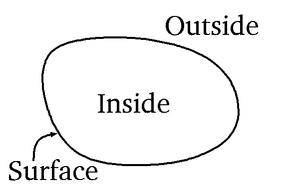About F-rep
In F-rep (function representation), a geometric object is defined by a single real continuous function F(x1, x2, x3, …, xn) >= 0. Let's think why F(x1, x2, x3, …, xn) >= 0 can represent an object.
A geometric object in 3D space is described by: the inside, the surface, and the outside.
We assume that F(x1, x2, x3, …, xn) >= 0 is a rule which determines where a given point belongs, that is:
F(x1, x2, x3, ..., xn) > 0 : the inside of an object F(x1, x2, x3, ..., xn) = 0 : the surface of an object F(x1, x2, x3, ..., xn) < 0 : the outside an object
To make a mesh of triangles (polygonize) on the surface of an F-rep object, the function has to be sampled in space. The bounding box is used to limit a range of sampling in space, and it is divided into fixed-size grids. The function is sampled in each node of the grid; then polygons are generated based on the sampled values of the function. The high grid density makes a good approximation of an object, but the number of polygons increases. See F-Rep page for more details about F-rep.
HyperFun Polygonizer samples the specified function in 3D space to visualize an F-rep object described in HyperFun. The bounding box has a default size of 20, and the grid density is 30 along each axis. You can change the size of the bounding box and the grid density, when using HyperFun Polygonizer.

